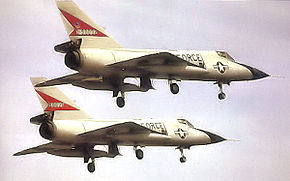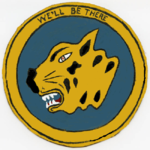11th Pursuit Squadron
11th Fighter-Interceptor Squadron
 |
|
|---|---|

Two squadron Convair F-106s preparing to land about 1967
|
|
| Active | 1941-1946; 1952–1968 |
| Country |
|
| Branch |
|
| Role | Fighter-Interceptor |
| Part of | Air Defense Command |
| Nickname(s) | The Aleutian Tigers (WW II) |
| Motto(s) | Infirme Ibimus Latin We'll Go Through Hell We'll Be There (WW II) |
| Insignia | |
| Patch with 11th Fighter-Interceptor Squadron emblem (approved 30 November 1954) |  |
| 11th Fighter Squadron emblem (WW II) |  |
The 11th Fighter-Interceptor Squadron is an inactive United States Air Force unit. Its last assignment was with the 343d Fighter Group at Duluth Airport, Minnesota, where it was inactivated on 30 June 1968.
The squadron was activated as the 11th Pursuit Squadron at Selfridge Field, Michigan in January 1941 as one of the original squadrons of the 50th Pursuit Group. It trained with Vultee BT-13 Valiant and second-line Seversky P-35 Guardsman pursuit fighters at Selfridge. In September, the squadron moved to Key Field, Mississippi, where it equipped with Curtiss P-40 Warhawks.
Shortly after the Japanese attack on Pearl Harbor, the 11th was dispatched to Elmendorf Field to reinforce the defenses of Alaska against Japanese attack, departing on 19 December. The urgency of the need for reinforcements in Alaska was so great that the squadron was picked even though its pilots were untrained on the flight conditions they could expect to experience in Alaska. Two weeks elapsed before the planes reached the Sacramento Air Depot for winterization, and at the end of the month when the 11th was officially located at Elmendorf, none of its planes had left McClellan Field. Bad weather delayed necessary test flights and caused the loss of some of the squadron's Warhawks. The first plane finally left California on 1 January 1942. The lack of adequate landing fields en route, poor communications, and pilot inexperience further delayed the squadron's movement. By 25 January only 13 of the 11th's twenty-five P-40s were at Elmendorf in flyable condition and six others had been lost during the movement.
...
Wikipedia
